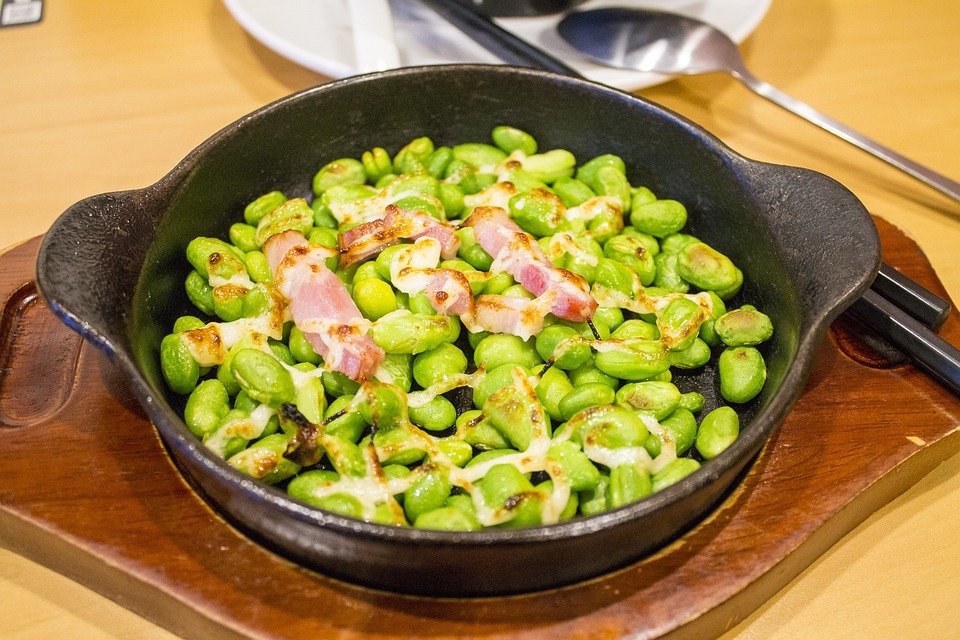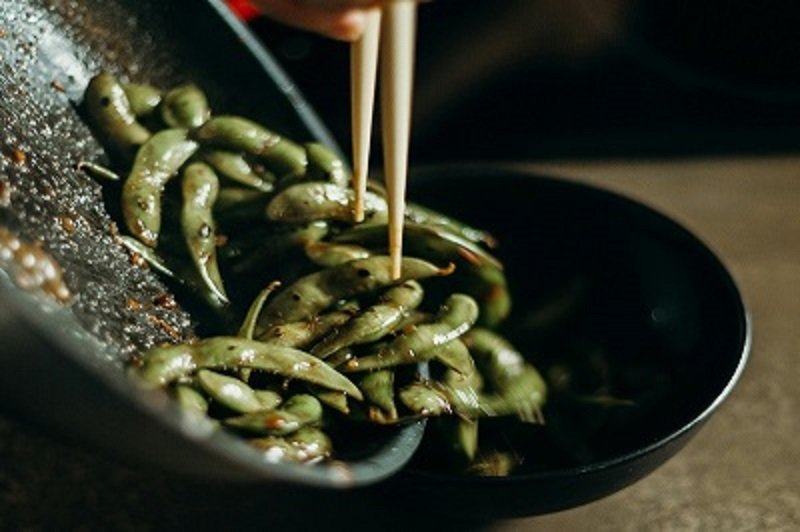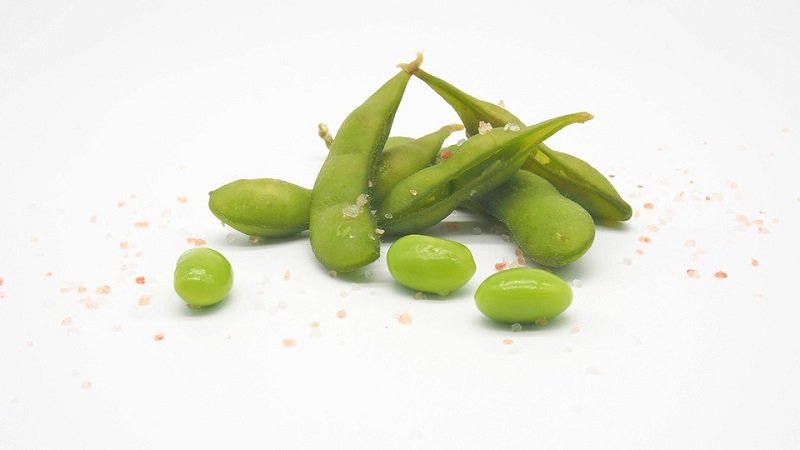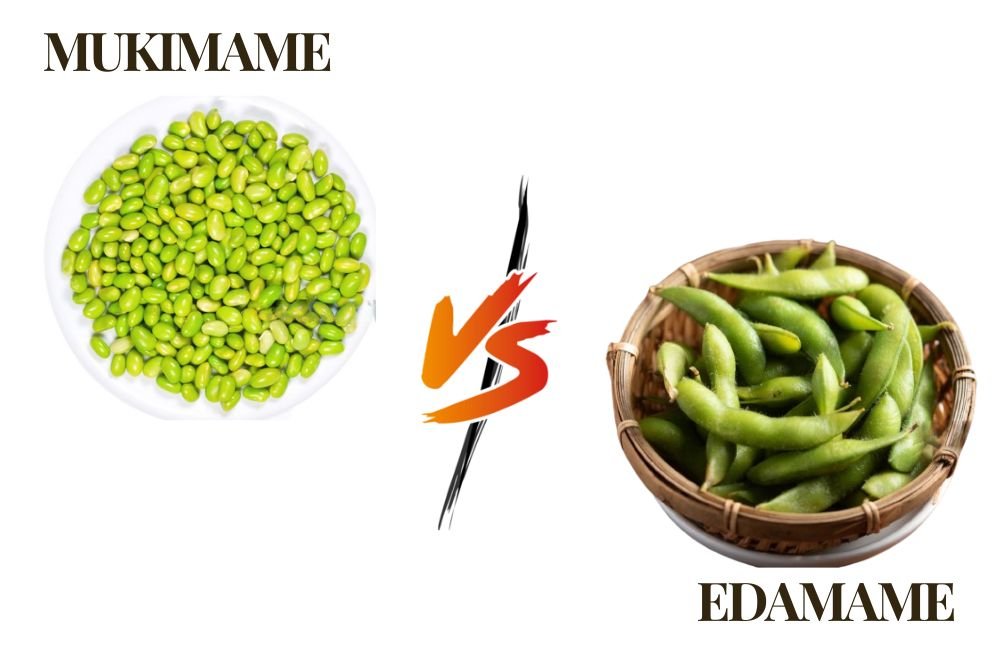Mukimame and edamame, both derived from soybeans, have gained immense popularity worldwide for their nutritional value and versatility. While often used interchangeably, these two terms represent distinct stages in the soybean’s lifecycle. This article delves into the nuances of mukimame vs edamame, covering their definitions, production, nutritional profiles, culinary applications, and health benefits.
Mukimame vs Edamame: Definition and Origin
| Aspect | Mukimame | Edamame |
| Definition | Mukimame refers to shelled edamame, meaning the beans have been removed from their pods. | Edamame are immature soybeans still in their pods. |
| Origin | Both mukimame and edamame originate from East Asia, particularly Japan, China, and Korea. Mukimame is simply the podded version of edamame. | Originates from East Asia, primarily Japan, where they have been consumed for centuries as a snack and ingredient. |
Both have become popular in global cuisines, particularly within health-conscious communities. Now, let’s look into other aspects of mukimame vs edamame.
1. Appearance and Texture
| Aspect | Mukimame | Edamame |
| Appearance | Bright green beans that are round and smooth, often appearing glossy when cooked | Bright green pods that encase the soybeans, with a slightly fuzzy exterior |
| Texture | Firm yet tender, with a slightly nutty flavor; similar to peas or lima beans | Firm texture, slightly crunchy when bitten, but tender inside; fibrous and inedible pods |
2. Nutritional Content
As mukimame and edamame stem from the same plant, their nutritional values remain the same.
| Nutrient | Mukimame/Edamame (per 100 g) |
| Calories | ~120 kcal |
| Protein | ~11 g |
| Carbohydrates | ~9 g |
| Fiber | ~5 g |
| Fat | ~5 g |
| Vitamins | Rich in Vitamin K, Folate, and Vitamin C |
| Minerals | High in Iron, Calcium, Magnesium, and Potassium |
3. Culinary Uses
| Aspect | Mukimame | Edamame |
| Common Dishes | Used in salads, stir-fries, soups, and as a snack | Often served as a snack, appetizer, or side dish |
| Preparation Methods | Cooked by boiling or steaming, then added directly to dishes | Usually boiled or steamed in their pods; salt is often added before serving |
| Ease of Use | More convenient for quick recipes since the beans are already shelled | Requires more preparation (shelling), but provides a fun, hands-on eating experience |


4. Health Benefits
| Aspect | Mukimame | Edamame |
| Protein Content | High protein content makes it an excellent plant-based protein source | Equally high in protein, supporting muscle growth and repair |
| Fiber Content | High fiber helps with digestion and maintaining a healthy weight | High fiber content promotes digestive health and satiety |
| Antioxidants | Contains antioxidants like isoflavones, which may reduce the risk of certain cancers | Rich in antioxidants, contributing to heart health and anti-inflammatory effects |
| Bone Health | High in calcium and magnesium, which are essential for bone health | Also high in calcium and magnesium, supporting strong bones |
| Heart Health | Low in saturated fat and cholesterol-free, promoting cardiovascular health | Similar heart health benefits, with the addition of potassium for blood pressure regulation |
5. Environmental Impact
| Aspect | Mukimame | Edamame |
| Sustainability | Generally sustainable to grow, requiring less water and resources compared to animal-based protein sources; has a low environmental footprint | Considered environmental-friendly, with a smaller carbon footprint than many animal-based proteins |
| Packaging | Often sold frozen in bags, with less packaging waste compared to edamame in pods | Typically sold in bulk or frozen in their pods, which can generate more packaging waste if not managed properly |
6. Cost and Availability
| Aspect | Mukimame | Edamame |
| Cost | Generally slightly more expensive due to additional processing (shelling) | Typically less expensive when purchased in bulk or fresh, as it requires less processing |
| Availability | Widely available in frozen sections of grocery stores, particularly in health food stores and Asian markets | Readily available in frozen form, and increasingly found fresh in supermarkets around the world |

7. Cultural Significance
| Aspect | Mukimame | Edamame |
| Cultural Context | Less culturally significant on its own, but is derived from the same tradition as edamame; Often used in contemporary or fusion cuisines | Has a deep-rooted cultural significance in Japan, where it has been consumed for centuries as a traditional snack, especially during summer |
8. Flavor and Taste
| Aspect | Mukimame | Edamame |
| Flavor Profile | Nutty and slightly sweet, with a rich umami taste; more pronounced because the beans are exposed | Mildly nutty, with a hint of sweetness; more subtle compared to mukimame |
| Best Pairings | Complements salads, rice dishes, and grain bowls; pairs well with bold flavors like soy sauce, garlic, and sesame oil | Often served with a sprinkle of sea salt; pairs well with simple seasonings like salt and lemon, or incorporated into rice and noodle dishes |
9. Production Process
| Feature | Mukimame | Edamame |
| Stage of Soybean | Mature | Immature |
| Harvesting | Harvested, shelled, and packaged | Harvested with pods intact |
| Processing | Minimal processing | May be frozen with pods |

10. Allergies and Dietary Considerations
- Both mukimame and edamame are soy products, so individuals with soy allergies should avoid them.
- Suitable for vegans, vegetarians, and those following gluten-free diets.
- Some individuals may experience digestive discomfort due to the high fiber content in them.
Mukimame vs Edamame: Which is Better?
Both mukimame and edamame offer similar nutritional benefits, being rich in protein, fiber, vitamins, and minerals. However, they differ in their preparation, culinary applications, and convenience. The choice between the two often comes down to personal preference, culinary needs, and the desired eating experience.
- Mukimame is ideal for those who prefer the convenience of ready-to-eat beans and enjoy incorporating them into various dishes.
- Edamame offers a fun and interactive eating experience and can be enjoyed as a snack or added to meals.
Incorporating either into your diet can contribute positively to your overall health, providing a nutritious and versatile option for plant-based protein. Whether you prefer the simplicity of mukimame or the hands-on enjoyment of edamame, both are excellent additions to a balanced diet.
We hope this article on mukimame vs edamame was helpful. Let us know what you want to learn more. Happy dieting!
FAQ
1. Is edamame keto?
Edamame is relatively low in carbohydrates, making it a suitable choice for a keto diet. One cup of cooked edamame contains about 13.8 grams of carbs, with 3.38 grams of sugar. It’s also rich in protein, fiber, and healthy fats. So, yes, edamame can be part of a keto-friendly diet.
2. Is edamame gluten-free?
Yes, edamame is naturally gluten-free. It’s a safe option for individuals with gluten sensitivity or celiac disease.
3. Is edamame FODMAP-friendly?
Edamame is considered FODMAP-friendly in moderate portions. While it contains some FODMAPs (fermentable carbohydrates), the overall content is relatively low. If you have irritable bowel syndrome (IBS), consult with a dietitian to determine your tolerance.
4. Can you freeze mukimame and edamame?
Yes, both mukimame (young lima beans) and edamame can be frozen. Simply blanch them in boiling water for a few minutes, cool them in ice water, and then freeze in airtight containers or bags.
5. Can I substitute mukimame for edamame in recipes (or vice versa)?
Absolutely! Mukimame and edamame have similar flavors and textures. You can swap them in recipes without major adjustments. Just ensure they’re cooked to the desired tenderness.
6. Do edamame and mukimame require the same cooking time?
Generally, yes. Both edamame and mukimame cook quickly—usually 5–10 minutes in boiling water. Adjust the cooking time based on your preference for tenderness.
7. Can edamame be eaten with the shell?
Yes, you can eat edamame with the shell. Simply boil or steam them, sprinkle them with sea salt, and enjoy by popping the beans out of the pod. The shell is edible but fibrous.
8. Can mukimame replace peas or green beans? Mukimame can indeed replace peas or green beans in various dishes. They offer a similar texture and taste. Experiment with them in stir-fries, salads, or casseroles.
Also Read The Top Best 10 Skin Tightening Foods You Need in Your Diet!






